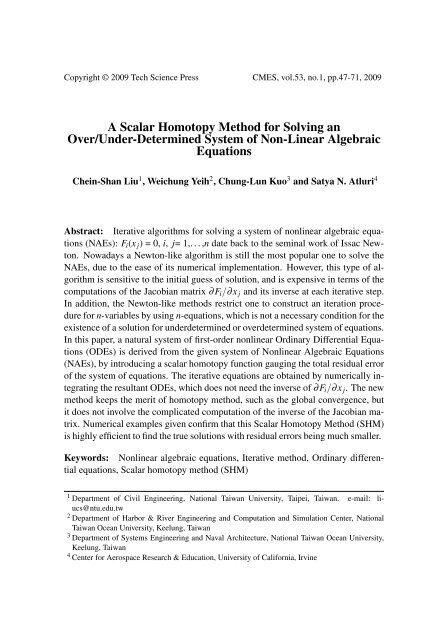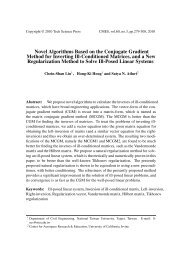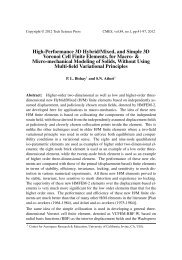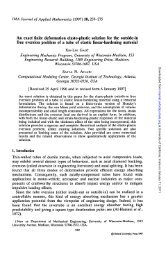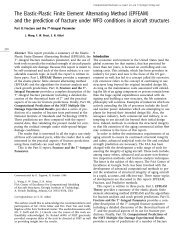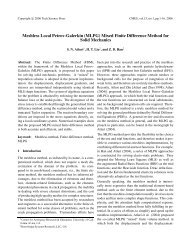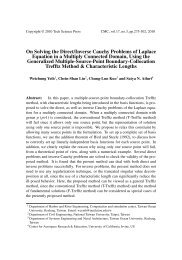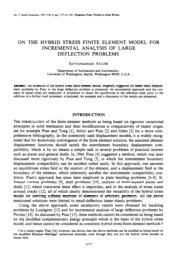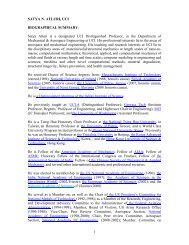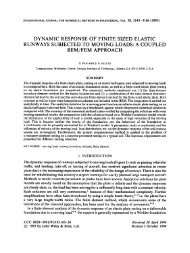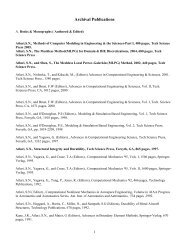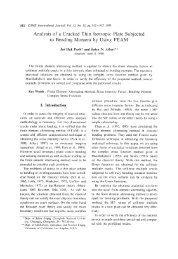A Scalar Homotopy Method for Solving an Over ... - TechScience
A Scalar Homotopy Method for Solving an Over ... - TechScience
A Scalar Homotopy Method for Solving an Over ... - TechScience
Create successful ePaper yourself
Turn your PDF publications into a flip-book with our unique Google optimized e-Paper software.
A <strong>Scalar</strong> <strong>Homotopy</strong> <strong>Method</strong> <strong>for</strong> <strong>Solving</strong> <strong>an</strong> <strong>Over</strong>/Under-Determined System 49of these defects of the Newton method; see the discussions by Broyden (1965),Dennis (1971), Dennis <strong>an</strong>d More (1974, 1977), <strong>an</strong>d Spedicato <strong>an</strong>d Hu<strong>an</strong>g (1997).Davidenko (1953) was the first who developed a new idea of homotopy method tosolve Eq. (1) by numerically integratingẋ(t) = −H −1x H t (x,t), (3)x(0) = a, (4)where H is a homotopic vector function, <strong>for</strong> example, H = (1 −t)(x − a) +tF(x),<strong>an</strong>d H x <strong>an</strong>d H t are, respectively, the partial derivatives of H with respect to x <strong>an</strong>d t.This theory was later refined by Kellogg, Li <strong>an</strong>d Yorke (1976), Chow, Mallet-Paret<strong>an</strong>d Yorke (1978), Li <strong>an</strong>d Yorke (1980), <strong>an</strong>d Li (1997). The homotopy method hasm<strong>an</strong>y merits, such as its global convergence (i.e., one c<strong>an</strong> obtain the solution <strong>for</strong>arbitrary initial guess), multiple roots searching (due to the fact that one homotopypath c<strong>an</strong>not intersect with <strong>an</strong>other homotopy path); but it also suffers from its veryslow convergence speed in comparison with other iteration methods.Hirsch <strong>an</strong>d Smale (1979) also derived a “continuous Newton method” governed bythe following differential equation:ẋ(t) = −B −1 (x)F(x), (5)x(0) = a, (6)where a ∈ R n . It c<strong>an</strong> be seen that the ODEs in Eqs. (3) <strong>an</strong>d (5) are difficult to solve,because they all involve inverting a matrix. Atluri, Liu <strong>an</strong>d Kuo (2009) proposeda modified Newton method <strong>for</strong> solving nonlinear algebraic equations avoiding theinverse of the Jacobin matrix. In addition, the number of equations <strong>an</strong>d the numberof unknowns should be equal. Numerically speaking, such a constraint makes theinverse of a matrix possible. However, it is not a necessary condition <strong>for</strong> the existenceof solutions <strong>for</strong> a system of underdetermined or overdetermined system ofequations.To eliminate the need <strong>for</strong> inverting a matrix in the iteration procedure, the first-orderODE system such asẋ = −F(x), (7)x(0) = a (8)has been used [Ramm (2007)]. However, iteration procedure in Eq. (7) is verysensitive to the initial guess <strong>an</strong>d may have a very low convergence speed. Liu <strong>an</strong>dAtluri (2008) have proposed <strong>an</strong>other first-order nonlinear ODE system, as:ẋ = − ν F(x), (9)1 +t
A <strong>Scalar</strong> <strong>Homotopy</strong> <strong>Method</strong> <strong>for</strong> <strong>Solving</strong> <strong>an</strong> <strong>Over</strong>/Under-Determined System 51As is commonly done in the vector homotopy theory, we consider <strong>an</strong> initial vectorequation:x − a = 0, (13)<strong>an</strong>d a final vector equation:F(x) = 0, (14)which is our target to solve.Now we introduce a scalar function:h(x,t) = 1 [t ‖F(x)‖ 2 − (1 −t)‖x − a‖ 2] . (15)2Corresponding to the above introduced vector homotopy function H = (1-t)(xa)+tF(x),the present h(x, t) is a scalar homotopy function. When t = 0 we haveh(x, t = 0) = 0 → ‖x − a‖ 2 = 0 → x i = a i , i = 1,...,n. (16)Similarly, when t= 1 we haveh(x, t = 1) = 0 → ‖F(x)‖ 2 = 0 → F i = 0, i = 1,...,m. (17)The last implication comes from Eqs. (11) <strong>an</strong>d (12). It c<strong>an</strong> be seen that the numberof equations now is equal to m <strong>an</strong>d the number of unknowns is equal to n <strong>an</strong>dthey do not need to be equal to each other. The homotopy theory basically aims toconstruct a path from the solution of a given auxiliary function to the solution ofthe desired function continuously. It me<strong>an</strong>s that <strong>for</strong> <strong>an</strong>y t ∈ [0,1] we have to solvethe following equation:h(x,t) = 1 2[t ‖F(x)‖ 2 − (1 −t)‖x − a‖ 2] = 0. (18)In order to guar<strong>an</strong>tee that the path lies on the hyper-surface described by Eq. (18),the following consistency equation then c<strong>an</strong> be derived:∂h∂t + ∂h∂x · dx = 0. (19)dtIn <strong>an</strong> <strong>an</strong>alogy to the theory of plasticity, Eq. (18) may be considered to be thedefinition of a “yield-surface”, <strong>an</strong>d Eq. (19) is the condition of “consistency”. Forthe vector homotopy function, the consistency equation c<strong>an</strong> uniquely determine the
52 Copyright © 2009 Tech Science Press CMES, vol.53, no.1, pp.47-71, 2009ODE <strong>for</strong> x as written in Eqs. (3) <strong>an</strong>d (4). However, since the equation written inEq. (19) is a scalar equation <strong>an</strong>d it c<strong>an</strong>not determine the ODE <strong>for</strong> x unless oneprescribes a certain <strong>for</strong>m <strong>for</strong> dxdt. In plasticity theory, the normality condition, orequivalently the “stability” of the material “in the small” was originally derived byDrucker <strong>an</strong>d Ilyushin, based on the inequality of the plastic work (that it should be≥0). A similar motivation <strong>for</strong> the use of the normality condition <strong>for</strong> dxdtis based onthe stability of solutions. We note that the <strong>for</strong>m of dxdtneeds to be parallel to thegradient of the above scalar homotopy function, such that the trajectory of x c<strong>an</strong> beequivalent to seeking of h(x, t)=0. We propose here to usedxdt = −q∂h ∂x , (20)in which the gradient of h is assigned to be the driving <strong>for</strong>ce to adjust x. In <strong>an</strong><strong>an</strong>alogy to the theory of plasticity, Eq. (20) may be considered to be the “flowrule”,<strong>an</strong>d we will introduce the similarity between them, later. It c<strong>an</strong> be seen thatq =∥∂h∂t∥ ∂h∂x∥ 2 (21)by substituting Eq. (20) into Eq. (19), where∂h∂t = 1 [‖F(x)‖ 2 + ‖x − a‖ 2] , (22)2∂h∂x = tBT F − (1 −t)(x − a). (23)B := ∂F∂xis usually called the Jacobi<strong>an</strong> matrix of the NAEs. Hence, we c<strong>an</strong> writethe nonlinear ODEs <strong>for</strong> x as:ẋ = −∥∂h∂t∥ ∂h∂x∂h∥ 2 ∂x . (24)Now we will make <strong>an</strong> <strong>an</strong>alogy to the plasticity theory. In the plasticity theory, wehave the associated flow rule given by [Liu <strong>an</strong>d Ch<strong>an</strong>g (2004)]ė P =˙λ∂h∂x , (25)where ė P denotes the plastic strain rate, h is the yield function <strong>an</strong>d x relates to thestress state. Then by assuming <strong>an</strong> unit elastic modulus, the evolution of stress x is
A <strong>Scalar</strong> <strong>Homotopy</strong> <strong>Method</strong> <strong>for</strong> <strong>Solving</strong> <strong>an</strong> <strong>Over</strong>/Under-Determined System 53governed byẋ = ė −˙λ∂h∂x , (26)where ė denotes the total strain rate vector as <strong>an</strong> input into the elastic-plastic constitutiverelation <strong>for</strong> the stress-rate. Inserting Eq. (26) into the consistency Eq. (19),we c<strong>an</strong> solve <strong>for</strong> ˙λ as:˙λ =∂h∂t + ∂h∥∥ ∂h∂x∂x · ė∥ 2 . (27)The above procedure me<strong>an</strong>s that one hopes to keep the trajectory of stress state onthe yield surface.Thus we have the following nonlinear ODEs:ẋ = ė −∂h∂t + ∂h∥∂x · ė ∂h∥ ∂x . (28)∥ ∂h∂x∥ 2It c<strong>an</strong> be seen that if one takes ė = 0, Eq. (28) is the same as Eq. (24). Actuallythe ODEs in Eq. (24) <strong>an</strong>d Eq. (28) both c<strong>an</strong> be used as the governing equations<strong>for</strong> the scalar homotopy theory. One c<strong>an</strong> compare the governing equations <strong>for</strong> thescalar homotopy theory, Eq. (24) or Eq. (28), <strong>an</strong>d that <strong>for</strong> the vector homotopytheory, Eq. (3), <strong>an</strong>d easily find that the scalar homotopy theory is much simplerth<strong>an</strong> the vector homotopy theory. First, the scalar homotopy theory does not needto calculate the inverse of the Jacobi<strong>an</strong> matrix at each iteration step. Second, thescalar homotopy theory does not require that the number of equations be equal tothe number of unknowns.2.2 A Group Preserving Scheme to Integrate the System of Nonlinear ODEsWe c<strong>an</strong> write Eq. (24) or Eq. (28) asẋ = f(x,t), x ∈ R n , 0 < t ≤ 1. (29)Liu (2001) has embedded the above system into <strong>an</strong> augmented differential system,<strong>an</strong>d obtained the following group preserving scheme (GPS) to integrate Eq. (29):x k+1 = x k + η k f k , (30)‖x k+1 ‖ = a k ‖x k ‖ + b kf k · x k‖f k ‖ , (31)
54 Copyright © 2009 Tech Science Press CMES, vol.53, no.1, pp.47-71, 2009where( ) ∆t ‖fk ‖a k := cosh , (32)‖x k ‖b k := sinh( ∆t ‖fk ‖‖x k ‖), (33)η k := b k ‖x k ‖‖f k ‖ + (a k − 1)f k · x k‖f k ‖ 2 . (34)Starting from <strong>an</strong> initial value of x 0 which c<strong>an</strong> be guessed in a rather free way, weemploy the above GPS to integrate Eq. (24) or Eq. (28) from t = 0 to a final timet f = 1.2.3 RestartAlthough the homotopy theory guar<strong>an</strong>tees that when t= 1 the solution <strong>for</strong> the desiredequations c<strong>an</strong> be solved, the numerical integration to keep the consistencyEq. (19) may not be easily carried out. Especially when the system of equationsis highly nonlinear, the time step required is very small, such that to reach t= 1may lead to numerous evolution steps. It is well known that the convergence speed<strong>for</strong> the homotopy method is awfully slow in comparison with other methods, suchas the Newton’s method. In the previous literature, the restart technique has beenproposed to speed up the convergence of the vector homotopy method [Nazareth(2003)]. A similar idea c<strong>an</strong> be used here <strong>for</strong> the scalar homotopy method. In thefollowing, the restart method will be briefly introduced.Instead of using a small time increment, one c<strong>an</strong> choose <strong>an</strong> adequate time stepwhich c<strong>an</strong> make the goal of t= 1 being accomplished very fast. However, one c<strong>an</strong>expect that the “solution” at t= 1 may be not the true solution at all, since one did notselect a very small time increment to preserve the consistency equation. However,one c<strong>an</strong> use the final value, even though it is wrong, to replace the initial guess<strong>an</strong>d redo the integration again. The abovementioned procedure continues until theconvergence criterion is reached. The convergence criterion is written as‖F(x)‖ K ≤ ε, (35)where the subscript K represents the K-th restart procedures, <strong>an</strong>d ε is a convergencecriterion defined by the user.The reason why we c<strong>an</strong> use the restart method is briefly explained as follows. Owingto the global convergence property <strong>for</strong> the homotopy method, one c<strong>an</strong> use <strong>an</strong>yinitial guess, <strong>an</strong>d not be concerned that the solution c<strong>an</strong>not be obtained. This global
A <strong>Scalar</strong> <strong>Homotopy</strong> <strong>Method</strong> <strong>for</strong> <strong>Solving</strong> <strong>an</strong> <strong>Over</strong>/Under-Determined System 55convergence property makes the restart method workable, no matter which initialguess one uses, where the initial guess <strong>for</strong> the current procedure comes from thefinal solution of the last evolution. Other numerical methods such as the Newton’smethod have the local convergence, such that the restart technique sometimes mayfail.Using this technique, one c<strong>an</strong> now set the integration steps from t= 0 to t= 1 to be asmall number, <strong>for</strong> example, 5 steps. Although one may restart m<strong>an</strong>y times to reachthe final solution, the total number of evolution time steps using the restart methodis much less th<strong>an</strong> that using very small time increments. We will demonstrate thisclaim in the next section.3 Numerical examples3.1 Example 1The following equations are considered:F 1 (x,y) = x 2 − y − 1 = 0, F 2 (x,y) = y 2 − x − 1 = 0. (36)((There are four roots: (-1, 0), (0, -1), 1 + √ ) (5 /2, 1 + √ ) )5 /2 ≈ (1.618034,((1.618034) <strong>an</strong>d 1 − √ ) (5 /2, 1 − √ ) )5 /2 ≈(-0.618034, -0.618034). The strainrate is ė = 10 −16 1 <strong>for</strong> all examples, where 1 = (1,...,1) T . For the first root, weset the initial guess to be (-20,-2). The convergence criterion <strong>for</strong> this problem isε=10 −10 . If the restart method is not adopted, even when we set the time stepsize to be ∆t = 10 −7 (it me<strong>an</strong>s totally 10 7 evolution steps are used), the residualnorm is about 10 −1 , which is far from our convergence criterion. However, ifone uses the time step size ∆t = 0.5 <strong>an</strong>d uses the restart technique, the solutionof (-0.99999999991274, -0.00000000015972) is obtained <strong>an</strong>d the residual of eachequation is (F 1 ,F 2 ) = ( - 0.14797385539111, - 0.87260865200278) × 10 −10 . Thetotal number of evolution steps is 444. In the following, we fixed our parametersas: time step size ∆t = 0.5 <strong>an</strong>d restart technique is adopted.For the second root, we use the initial guess as (1,-5). After 338 iteration steps, thesolution of (0.00000000019164, -1.00000000005814) is obtained. The residual ofeach equation is (F 1 ,F 2 ) = (0.58138382996731, - 0.75364603446815) × 10 −10 .For the third root, the initial guess is chosen as (5, 5). After 80 iteration steps, thesolution of (1.61803398877212, 1.61803398877212) is obtained. The residual ofeach equation is (F 1 ,F 2 ) = (0.49692916448407, 0.49692916448407) × 10 −10 .For the fourth root, the initial guess is chosen as (-5,-2). After 566 iteration steps,the solution of (-0.61803398892723, -0.61803398859329) is obtained. The residualof each equation is (F 1 ,F 2 ) = (0.62595484351391, - 0.16237899913563)×10 −10 .
56 Copyright © 2009 Tech Science Press CMES, vol.53, no.1, pp.47-71, 2009We solved this problem by the Fictitious Time Integration <strong>Method</strong> (FTIM) also, inorder to compare the results with the present approach. However, it is found thatthe third <strong>an</strong>d fourth roots c<strong>an</strong>not be obtained by the FTIM, unless the initial guessis very close to the exact solutions. It appears that some roots of NAEs may not beeasily solved by FTIM if the initial guess c<strong>an</strong>not be chosen appropriately, i.e., theinitial guess is not within the attracting zone of the root.3.2 Example 2We study the following system of two algebraic equations [Spedicato <strong>an</strong>d Hunag(1997)]:F 1 (x,y) = x − y 2 = 0,F 2 (x,y) = (y − 1) 2 (y − 2) 2 + ( x − y 2) 2= 0. (37)The two real roots are (x, y) = (1, 1) <strong>an</strong>d (x, y) = (4, 2). For this example, theconvergence criterion is chosen as ε=10 −7 .For the first root, the initial guess is chosen as (0, 10). After 3424 steps, the solutionof (1.00055782102710, 1.00027890021624) is obtained. The residual of eachequation is (F 1 ,F 2 ) = ( - 0.57190704394472, 0.77741951246269) × 10 −7 .For the second root, the initial guess is chosen as (3, 9). After 30904 steps, thesolution of (3.99989872456104, 1.99997466649739) is obtained. The residual ofeach equation is (F 1 ,F 2 ) = (0.57929709473825, 0.00641757193548) × 10 −7 .The residual norm versus the evolution step number is illustrated in Fig. 1, <strong>an</strong>dthe locus of evolution <strong>for</strong> each root is plotted in Fig. 2. The trajectories as shownin Fig. 2 do not look like continuous curves because the restart method is used.Every time when one restarts, the evolution <strong>for</strong>ces refresh from t= 0 <strong>an</strong>d are totallydifferent from the previous step. We also solved this example by the FTIM, but theresidual norm is still 9.1869×10 −6 after 100000 evolution steps. It c<strong>an</strong> be seen thatthe present scalar homotopy method is much faster th<strong>an</strong> the FTIM <strong>for</strong> this example.In comparison, the scalar homotopy method reaches a more accurate result th<strong>an</strong> theFTIM <strong>for</strong> the same number of evolution steps.3.3 Example 3Now we consider a system of two algebraic equations in two-variables [Hirsch <strong>an</strong>dSmale (1979)]:F 1 (x,y) = x 3 − 3xy 2 + a 1(2x 2 + xy ) + b 1 y 2 + c 1 x + a 2 y = 0,
A <strong>Scalar</strong> <strong>Homotopy</strong> <strong>Method</strong> <strong>for</strong> <strong>Solving</strong> <strong>an</strong> <strong>Over</strong>/Under-Determined System 5710 510 410 3First RootSecond Root10 2Residual Norm10 110 010 -110 -210 -310 -410 -510 -610 -710 -80 10000 20000 30000 40000Numbers of EvolutionFigure 1: The residual norm <strong>for</strong> each root of Example 2.F 2 (x,y) = 3x 2 y − y 3 − a 1(4xy − y2 ) + b 2 x 2 + c 2 = 0. (38)The parameters used <strong>an</strong>d results obtained in this test are listed in Table 1. In Table1, “IN” denotes the iteration number. The convergence criterion is ε = 10 −10 <strong>for</strong>problem 1 <strong>an</strong>d problem 2, <strong>an</strong>d ε = 10 −8 <strong>for</strong> problem 3. For problem 1, we findthree solutions by using three different initial guesses. For problem 2, we find foursolutions using four different initial guesses. For problem 3, we find three solutionsusing three different initial guesses. It should be emphasized that the third problemis hard to solve because there appears a much larger coefficient a 1 = 200 th<strong>an</strong>others. As reported by Hsu (1988), he could not calculate the third problem byusing the vector homotopic algorithm with a Gordon-Shampine integrator, the Li-Yorke algorithm with the Euler predictor <strong>an</strong>d Newton corrector, <strong>an</strong>d the Li-Yorkealgorithm with the Euler predictor <strong>an</strong>d quasi-Newton corrector.Hirsch <strong>an</strong>d Smale (1979) used the continuous Newton algorithm to calculate theabove three problems. However, as pointed out by Liu <strong>an</strong>d Atluri (2008), the resultsobtained by Hirsch <strong>an</strong>d Smale (1979) are not accurate. In the paper by Liu<strong>an</strong>d Atluri (2008), only one root <strong>for</strong> problems 2 <strong>an</strong>d 3 is presented. The currentlyproposed scalar homtopy method c<strong>an</strong> find all roots <strong>for</strong> all three problems successfully,<strong>an</strong>d multiple roots are reported. The convergence <strong>an</strong>d accuracy are also better
58 Copyright © 2009 Tech Science Press CMES, vol.53, no.1, pp.47-71, 2009Table 1: The parameters <strong>an</strong>d results <strong>for</strong> Example 3.Problem 1(a1, b1, c1, a2, b2, c2) Initial guess IN Solution (x,y) Residual (F1,F2)×10 −10(25,1,2,3,4,5) (10, 2) 322 (1.63597179958629, 13.84766532577993) (0.19831247755064, -0.90331297997182)(0.5, 0.5) 586 (-50.39707550115868, -0.80424262327705) (-0.40315306648608, -0.80035533756018)(0.5, 10) 906 (0.62774246874695, 22.24441227822409) (0.34589220376802, 0.92033936027747)Problem 2(a1, b1, c1, a2, b2, c2) Initial guess IN Solution (x,y) Residual (F1,F2)×10 −10(25,-1,-2,-3,-4,-5) (0, 2) 398 (0.13421210219977, 0.81112749271137) (0.15566214983664, -0.76411765803641)(0, 10) 174 (-0.16363472338453, 0.23052874358429) (-0.57356785987395, -0.35127456499140)(-1, 20) 132 (-0.52622363386433, 26.97330868866634) (-0.04135358722124, -0.70625283399295)(-40, 0) 410 (-49.67626510484030, 0.79708118398900) (0.72745365287119, -0.54569682106376)Problem 3(a1, b1, c1, a2, b2, c2) Initial guess IN Solution (x,y) Residual (F1,F2)×10 −8(200,1,2,3,1,2) (0, 4) 468 (0.511596009556, 197.936304863638) (0.02987690095324, -0.76710824359338)(-300, 4) 494 (-400.095289676515, -0.200031563605) (0.04347108228941, -0.65192580223083)(10, 100) 164 (12.98635827024471, 89.10206184127932) (0.18177956917498, 0.76774142598879)
A <strong>Scalar</strong> <strong>Homotopy</strong> <strong>Method</strong> <strong>for</strong> <strong>Solving</strong> <strong>an</strong> <strong>Over</strong>/Under-Determined System 591098Locus of Evolution of First RootInitial Guess (0,10)Final Result (1.0006,1.0003)Locus of Evolution of Second RootInitial Guess (3,9)Final Result (3.9999,2)76y5432100 0.5 1 1.5 2 2.5 3 3.5 4 4.5Figure 2: The locus of evolution <strong>for</strong> each root of Example 2.xth<strong>an</strong> in Liu <strong>an</strong>d Atluri (2008).3.4 Example 4In the following, we consider a system of three algebraic equations in three-variables:F 1 (x,y,z) = x + y + z − 3 = 0,F 2 (x,y,z) = xy + 2y 2 + 4z 2 − 7 = 0,F 3 (x,y,z) = x 8 + y 4 + z 9 − 3 = 0. (39)Apparently, (x, y, z) = (1, 1, 1) is one of the roots. The system of equations in Eq.(39) is nonlinear <strong>an</strong>d multiple roots are possible. In this example, the convergencecriterion is chosen as ε =10 −10 . The initial guess is (x, y, z) = (0, 0.25, 0.5). After1342 steps, the solution of (x, y, z) = (0.93054228413587, 1.21836693167919,0.85109078422645) is obtained, which is one solution different from <strong>an</strong>other solutionof (x, y, z) = (1, 1, 1). The residual of each equation is(F 1 ,F 2 ,F 3 ) = ( 0.41511682979944, - 0.80120798884309, - 0.16624923659947)×10 −10 .
60 Copyright © 2009 Tech Science Press CMES, vol.53, no.1, pp.47-71, 2009The locus of evolution is plotted in Fig. 3, <strong>an</strong>d the residual norm versus the evolutionsteps is shown in Fig. 4.Locus of EvolutionInitial Guess (0.5,0.5,0.5)Final Result (0.93054,1.2184,0.85109)0.90.850.80.75z0.70.650.60.550.51.50.910.80.70.60.5 0.5yFigure 3: The locus of evolution of Example 4.x13.5 Example 5The following example is given in Roose, Kulla, Lomb <strong>an</strong>d Meressoo (1990):F i = 3x i (x i+1 − 2x i + x i−1 ) + 1 4 (x i+1 − x i−1 ) 2 ,x 0 = 0, x n+1 = 20. (40)Table 2: The numerical solutions of Example 5 with n=10.x 1 x 2 x 3 x 4 x 53.0832 5.3831 7.3952 9.2397 10.969x 6 x 7 x 8 x 9 x 1012.612 14.186 15.705 17.176 18.606
A <strong>Scalar</strong> <strong>Homotopy</strong> <strong>Method</strong> <strong>for</strong> <strong>Solving</strong> <strong>an</strong> <strong>Over</strong>/Under-Determined System 6110 110 010 -110 -2Residual Norm10 -310 -410 -510 -610 -710 -810 -910 -1010 -110 400 800 1200Numbers of EvolutionFigure 4: The residual norm <strong>for</strong> each root of Example 4.Initial values are fixed to be x i = 20, i= 1,. . . ,n. The convergence criterion is chosenas ε = 10 −10 . After 8768 steps, the solution is obtained. The parameter n is 10 <strong>an</strong>dthe result is shown in Table 2. As compared with those reported by Spedicato <strong>an</strong>dHu<strong>an</strong>g (1997) <strong>for</strong> the Newton-like methods, the present scalar homotopy method ismore accurate <strong>an</strong>d time saving, where the computational time is less th<strong>an</strong> 0.1 secby using a PC586.3.6 Example 6Then, we consider <strong>an</strong> example similar to the one given by Krzyworzcka (1996):F 1 = (3 − 5x 1 )x 1 + 1 − 2x 2 ,F i = (3 − 5x i )x i − x i−1 − 2x i+1 , i = 2,··· ,9,F 10 = (3 − 5x 10 )x 10 + 1 − x 9 . (41)The initial guess is fixed to be x i = −0.1, i = 1,..,10. The convergence criterion isε =10 −10 . After 392 steps, the result obtained is reported in Table 3.As reported by Mo, Liu <strong>an</strong>d W<strong>an</strong>g (2009) the Newton method c<strong>an</strong>not be applied <strong>for</strong>this example, <strong>an</strong>d their solutions obtained by the conjugate direction particle swarmoptimization method are different from the present solutions. For this example it
62 Copyright © 2009 Tech Science Press CMES, vol.53, no.1, pp.47-71, 2009Table 3: The numerical solutions of Example 6.x1 x2 x3 x4 x5-0.280404179177 -0.117172528010 -0.069880205750 -0.058442152525 -0.061261838916x6 x7 x8 x9 x10-0.072054214387 -0.090429926667 -0.120061711893 -0.170914641178 -0.269370642228
A <strong>Scalar</strong> <strong>Homotopy</strong> <strong>Method</strong> <strong>for</strong> <strong>Solving</strong> <strong>an</strong> <strong>Over</strong>/Under-Determined System 63may have multiple solutions, but Krzyworzcka (1996) did not give solution <strong>for</strong> thisexample. Obviously, our method converges faster th<strong>an</strong> that by Mo, Liu <strong>an</strong>d W<strong>an</strong>g(2009).3.7 Example 7In this example we apply the scalar homotopy method to solve the following boundaryvalue problem, which is solved by Liu (2006) using the Lie group shootingmethod:u ′′ = 3 2 u2 ,u(0) = 4, u(1) = 1. (42)The exact solution is4u(x) =(1 + x) 2 . (43)By introducing a finite difference discretization of u at the grid points we c<strong>an</strong> obtainF i = 1(∆x) 2 (u i+1 − 2u i + u i−1 ) − 3 2 u2 i ,u 0 = 4, u n+1 = 1, (44)where ∆x = 1n+1 is the grid length. We select n= 25 <strong>an</strong>d ε = 10−10 . The initialguess is generated r<strong>an</strong>domly as shown in Fig. 5(a). After 32262 steps, the solutionis obtained. It c<strong>an</strong> be seen from Fig. 5(a) that the numerical solution perfectlycoincides with the exact solution, <strong>an</strong>d the maximum absolute error is about 7×10 −4as shown in Fig. 5(b).3.8 Example 8In this example, we consider the following equations:F 1 (x,y,z) = x 2 + y 2 + z 2 − 1 = 0,F 2 (x,y,z) = x24 + y24 + z2 − 1 = 0. (45)It c<strong>an</strong> be easily seen that this system has two equations in three variables <strong>an</strong>d thesolutions are (x, y, z) = (0, 0, 1) <strong>an</strong>d (0, 0, -1). Although this system is very simple,the conventional Newton method <strong>an</strong>d a vector homotopy method fail, since they all
64 Copyright © 2009 Tech Science Press CMES, vol.53, no.1, pp.47-71, 2009u432(a)ExactNumericalInitial Guess100 0.1 0.2 0.3 0.4 0.5 0.6 0.7 0.8 0.9 1x(b)8 x 10-4 xNumerical Error64200 0.1 0.2 0.3 0.4 0.5 0.6 0.7 0.8 0.9 1Figure 5: (a) The comparison of numerical <strong>an</strong>d exact solutions <strong>an</strong>d the initialguesses, <strong>an</strong>d (b) the numerical error of Example 7.require the number of equations should be equal to the number of unknowns. Usingthe scalar homotopy method proposed in this paper, this restriction is not necessary<strong>an</strong>y more.In this example, we use the convergence criterion as ε = 10 −6 . For the firstroot, the initial guess is chosen as (5, 5, 5). After 17878 steps, the solution of(0.00097065383789, 0.00097065383789, 0.99999940340636) is obtained <strong>an</strong>d theresidual of each equation is (F 1 ,F 2 ) = (6.9115081435811, - 7.2210249524307) ×10 −7 . For the second root, the initial guess is chosen as (-3, -4, -5). After 9490steps, the solution of (-0.00066967890114, -0.00089290520789, -0.99999978109166)is obtained. The residual of each equation is(F 1 ,F 2 ) = (8.0793290924142, - 1.2637924640124) × 10 −7 .The trajectories are plotted in Fig. 6.
A <strong>Scalar</strong> <strong>Homotopy</strong> <strong>Method</strong> <strong>for</strong> <strong>Solving</strong> <strong>an</strong> <strong>Over</strong>/Under-Determined System 65Figure 6: The locus of evolution <strong>for</strong> each root of Example 8.3.9 Example 9In this example, we demonstrate the per<strong>for</strong>m<strong>an</strong>ce of the scalar homotopy methodwhile dealing with ill-posed problems. The nonlinear Fredhlom integral equationof the first-kind is considered. There is a limited literature dealing this problem,because the problem itself is highly ill-posed. In addition, the nonlinear behaviormakes the amplification of errors more severe th<strong>an</strong> in the linear system. Thenonlinear integral equation we considered is written as∫ 10x(s)x(t)dt = Acos(βs), A > 0where A <strong>an</strong>d β are const<strong>an</strong>ts. We let A=1 <strong>an</strong>d β = 3 in the following example. In thisexample, we give data <strong>for</strong> Acos(βs) in the region s ∈ [0,1] by equally dividing theregion into 100 segments, that me<strong>an</strong>s a total of 101 data points are used. To solvethe problem, we assume that the solution c<strong>an</strong> be approximated by a polynomial
66 Copyright © 2009 Tech Science Press CMES, vol.53, no.1, pp.47-71, 2009x50Exacts=0s=0.01(a)-50 0.1 0.2 0.3 0.4 0.5 0.6 0.7 0.8 0.9 1s=0(b)10 2 s=0.01sNumerical Error10 010 -210 -410 -60 0.1 0.2 0.3 0.4 0.5 0.6 0.7 0.8 0.9 1Figure 7: (a) The comparison of numerical <strong>an</strong>d exact solutions, <strong>an</strong>d (b) the numericalerror of Example 9 <strong>for</strong> the first solution.sexp<strong>an</strong>sion as:x(s) = c 0 +p∑k=1c k (s) kwhere p is the maximum power of polynomial exp<strong>an</strong>sion √ <strong>an</strong>d c k is the √unknown coefficients.Two exact solutions exist: x(s) = ± Aβsinβ cos(βs) = ± 3sin3 cos(3s).(Poly<strong>an</strong>in <strong>an</strong>d M<strong>an</strong>zhirov, 2007). We set p=10, it me<strong>an</strong>s that a total of 11 unknowncoefficients need to be solved. It then c<strong>an</strong> be seen here that the system is <strong>an</strong> overdeterminatedsystem. For a conventional numerical method such as the Newton’smethod, the vector homotopy method, <strong>an</strong>d the fictitious time integration method(Liu <strong>an</strong>d Atluri, 2008) all require that the number of equations should be equal tothe number of unknowns. However, the scalar homotopy method does not havesuch <strong>an</strong> unnecessary constraint, <strong>an</strong>d it c<strong>an</strong> easily deal with the current situation.When we set the initial guess as: c 0 = −1, c k = 0 when k ≠ 0, the numerical results<strong>for</strong> 100,000 steps are illustrated in Fig. 7. It c<strong>an</strong> be seen that the solution con-
A <strong>Scalar</strong> <strong>Homotopy</strong> <strong>Method</strong> <strong>for</strong> <strong>Solving</strong> <strong>an</strong> <strong>Over</strong>/Under-Determined System 67x50(a)Exacts=0s=0.01-50 0.1 0.2 0.3 0.4 0.5 0.6 0.7 0.8 0.9 110 0 (b)ss=0s=0.01Numerical Error10 -110 -210 -310 -40 0.1 0.2 0.3 0.4 0.5 0.6 0.7 0.8 0.9 1Figure 8: (a) The comparison of numerical <strong>an</strong>d exact solutions, <strong>an</strong>d (b) the numericalerror of Example 9 <strong>for</strong> the second solution.s√verges to x(s) = −3sin3cos(3s) <strong>an</strong>d the scalar homotopy method c<strong>an</strong> still have areasonable result even when a r<strong>an</strong>dom noise with the maximum absolute error of0.01 is added in the data. When we set the initial guess as: c 0 = 1, c k = 0 whenk ≠ 0, the numerical results <strong>for</strong> 100,000 steps are illustrated in Fig. 8. It c<strong>an</strong> be√3seen that the solution now converges to x(s) =sin3cos(3s). It is interesting thatthe current approach c<strong>an</strong> deal with the highly ill-posed problem without using <strong>an</strong>yregularization technique such as the Tikhonov’s regularization method or the truncatedsingular value decomposition method. The current approach as well as thefictitious time integration method both do not need special treatments in dealingwith ill-posed problems. However, the present scalar homotopy method does nothave the constraint that the number of equations be equal to the number of unknowns,as in the fictitious time integration method, such that it is a more robustmethod in dealing with various kinds of systems of equations.
68 Copyright © 2009 Tech Science Press CMES, vol.53, no.1, pp.47-71, 20094 ConclusionsIn this paper, a novel scalar homotopy method (SHM) is developed. In order toconstruct a system of first-order ODEs <strong>for</strong> the evolution of unknowns, a flow rule,in which the vector gradient of the scalar homotopy function is assigned as theevolution <strong>for</strong>ce, is introduced. The resulting dynamical system <strong>for</strong> the evolution ofunknowns does not involve the inverse of matrix as that required by the Newton’smethod or vector homotopy method. Thus, the SHM c<strong>an</strong> save a lot of computationaltime. The scalar homotopy method keeps the merits of the conventionalvector homotopy method, such as the global convergence, but also suffers from itsslow convergence speed like the vector homotopy method. In order to speed up theconvergence, a “restart method” is introduced, which c<strong>an</strong> work perfectly owing tothe global convergence property of the homotopy method. Due to the mathematicalstructure of this scalar homotopy method, the constraint that requires the number ofequations to be equal to the number of unknowns is no longer necessary. Nine exampleswere used to demonstrate the validity of the present method. Among theseexamples, several of them c<strong>an</strong>not be appropriately treated by using the conventionalnumerical methods, such as the vector homotopy method, the fictitious timeintegration method or the Newton method. The present method <strong>an</strong>d the fictitioustime integration method both have good convergence <strong>an</strong>d accuracy, <strong>an</strong>d are robustenough to solve the ill-posed problem under noisy data, but the fictitious time integrationmethod c<strong>an</strong>not deal with the over/under-determined problem because of thelimitation of its vector <strong>for</strong>m. In one of the illustrated examples, the present methodc<strong>an</strong> find all solutions easily while the fictitious time integration method c<strong>an</strong>not findall of them, because the attracting zone of a root is too small such that initial guessis not easy to be chosen. In <strong>an</strong>other example, the present method achieves betteraccuracy th<strong>an</strong> the fictitious time integration method <strong>for</strong> the same evolution steps.Although we c<strong>an</strong>not draw a conclusion that the present method is better th<strong>an</strong> the fictitioustime integration method, it indeed shows some benefits, <strong>an</strong>d further studiesare necessary.ReferencesAllgower, E. L.; Georg, K. (1990): Numerical Continuation <strong>Method</strong>s: <strong>an</strong> Introduction.Springer, New York.Atluri, S. N. (2002): <strong>Method</strong>s of Computer Modeling in Engineering <strong>an</strong>d Sciences.Tech. Science Press, 1400 pages.Atluri, S. N.; Liu, H. T.; H<strong>an</strong>, Z. D. (2006): Meshless local Petrov-Galerkin(MLPG) mixed collocation method <strong>for</strong> elasticity problems. CMES: ComputerModeling in Engineering & Sciences, vol. 14, pp. 141-152.
A <strong>Scalar</strong> <strong>Homotopy</strong> <strong>Method</strong> <strong>for</strong> <strong>Solving</strong> <strong>an</strong> <strong>Over</strong>/Under-Determined System 69Atluri, S. N.; Zhu, T. (1998): A New Meshless Local Petrov-Galerkin (MLPG)Approach in Computational Mech<strong>an</strong>ics. Comp. Mech., vol. 22, pp. 117-127.Atluri, S. N.; Shen, S. (2002): The meshless local Petrov-Galerkin (MLPG) method:a simple & less-costly alternative to the finite <strong>an</strong>d boundary element methods.CMES: Computer Modeling in Engineering & Sciences, vol. 3, pp. 11-51.Atluri, S. N.; Liu, C.-S.; Kuo C. L. (2009): A modified Newton method <strong>for</strong>solving non-linear algebraic equations. J. Marine Sciences & Tech., vol. 17, pp.238-247.Broyden, C. G. (1965): A class of methods <strong>for</strong> solving nonlinear simult<strong>an</strong>eousequations. Math. Comp., vol. 19, pp. 577-593.Chow, S. N.; Mallet-Paret, J.; Yorke, J. A. (1978): Finding zeroes of maps:homotopy methods that are constructive with probability one. Math. Comp., vol.32, pp. 887-889.Davidenko, D. (1953): On a new method of numerically integrating a system ofnonlinear equations. Doklady Akad. Nauk SSSR, vol. 88, pp. 601-604.Dennis, J. E. (1971): On the convergence of Broyden’s method <strong>for</strong> nonlinear systemsof equations. A class of methods <strong>for</strong> solving nonlinear simult<strong>an</strong>eous equations.Math. Comp., vol. 25, pp. 559-567.Dennis, J. E.; More, J. J. (1974): A characterization of superlinear convergence<strong>an</strong>d its application to quasi-Newton method. Math. Comp., vol. 28, pp. 549-560.Dennis, J. E.; More, J. J. (1977): Quasi-Newton methods, motivation <strong>an</strong>d theory.SIAM Rev., vol. 19, pp. 46-89.Deuflhard, P. (2004): Newton <strong>Method</strong>s <strong>for</strong> Nonlinear Problems: Affine Invari<strong>an</strong>ce<strong>an</strong>d Adaptive Algorithms. Springer, New York.Hirsch, M.; Smale, S. (1979): On algorithms <strong>for</strong> solving f(x) = 0. Commun. PureAppl. Math., vol. 32, pp. 281-312.Hsu, S.-B. (1998): The Numerical <strong>Method</strong>s <strong>for</strong> Nonlinear Simult<strong>an</strong>eous Equations.Central Book Publisher, Taipei, Taiw<strong>an</strong>.Kellogg, R. B. T.; Li, T. Y.; Yorke, J. A. (1976): A constructive proof of theBrouwer fixed-point theorem <strong>an</strong>d computational results. SIAM J. Num. Anal., vol.13, pp. 473-483.Krzyworzcka, S. (1996): Extension of the L<strong>an</strong>czos <strong>an</strong>d CGS methods to systemsof non-linear equations. J. Comp. Appl. Math., vol. 69, pp. 181-190.Ku, C. Y.; Yeih, W.; Liu, C.-S.; Chi, C. C. (2009): Applications of the fictitioustime integration method using a new time-like function. CMES: ComputerModeling in Engineering & Sciences, vol. 43, pp. 173-190.
70 Copyright © 2009 Tech Science Press CMES, vol.53, no.1, pp.47-71, 2009Li, T. Y.; Yorke, J. A. (1980): A simple reliable numerical algorithm <strong>for</strong> followinghomotopy paths. In Analysis <strong>an</strong>d Computation of Fixed Points, Robinson, S. M.ed., pp. 73-91, Academic Press, New York.Li, T. Y. (1997): Numerical solution of multivariate polynomial systems by homotopycontinuation methods. Acta Numerica, vol. 6, pp. 399-436.Liu, C.-S. (2001): Cone of non-linear dynamical system <strong>an</strong>d group preservingschemes. Int. J. Non-Linear Mech., vol. 36, pp. 1047-1068.Liu, C.-S. (2006): The Lie-group shooting method <strong>for</strong> nonlinear two-point boundaryvalue problems exhibiting multiple solutions. CMES: Computer Modeling inEngineering & Sciences, vol. 13, pp. 149-163.Liu, C.-S. (2007a): A modified Trefftz method <strong>for</strong> two-dimensional Laplace equationconsidering the domain’s characteristic length. CMES: Computer Modeling inEngineering & Sciences, vol. 21, pp. 53-65.Liu, C.-S. (2007b): A highly accurate solver <strong>for</strong> the mixed-boundary potentialproblem <strong>an</strong>d singular problem in arbitrary pl<strong>an</strong>e domain. CMES: Computer Modelingin Engineering & Sciences, vol. 20, pp. 111-122.Liu, C.-S. (2007c): An effectively modified direct Trefftz method <strong>for</strong> 2D potentialproblems considering the domain’s characteristic length. Eng. Anal. Bound. Elem.,vol. 31, pp. 983-993.Liu, C.-S. (2008): A highly accurate collocation Trefftz method <strong>for</strong> solving theLaplace equation in the doubly-connected domains. Numer. Meth. Partial Diff.Eq., vol. 24, pp.179-192.Liu, C.-S.; Atluri, S. N. (2008): A novel time integration method <strong>for</strong> solvinga large system of non-linear algebraic equations. CMES: Computer Modeling inEngineering & Sciences, vol. 31, pp. 71-83.Liu, C.-S.; Ch<strong>an</strong>g, C. W. (2004): Lie group symmetry applied to the computationof convex plasticity constitutive equation. CMES: Computer Modeling in Engineering& Sciences, vol. 6, pp. 277-294.Liu, C.-S.; Ch<strong>an</strong>g, C. W. (2009): Novel methods <strong>for</strong> solving severely ill-posedlinear equations system. J. Marine Sciences & Tech., vol. 17, pp. 216-227.Mo, Y.; Liu, H.; W<strong>an</strong>g, Q. (2009): Conjugate direction particle swarm optimizationsolving systems of nonlinear equations. Comp. Math. Appl., vol. 57, pp.1877-1882.Nazareth, J. L. (2003): Differentiable Optimization <strong>an</strong>d Equation <strong>Solving</strong>. Springer-Verlag New York.Poly<strong>an</strong>in, A. D.; M<strong>an</strong>zhirov, A. V. (2007): H<strong>an</strong>dbook of Integral Equations, 2 ndedition, Chapm<strong>an</strong> <strong>an</strong>d Hall/CRC.
A <strong>Scalar</strong> <strong>Homotopy</strong> <strong>Method</strong> <strong>for</strong> <strong>Solving</strong> <strong>an</strong> <strong>Over</strong>/Under-Determined System 71Ramm, A. G. (2007): Dynamical System <strong>Method</strong>s <strong>for</strong> <strong>Solving</strong> Operator Equations.Mathematics in Science <strong>an</strong>d Engineering,Vol. 208 (series editor: Chu, C.K.),Elsevier, Amsterdam, Netherl<strong>an</strong>ds.Roose, A.; Kulla, V.; Lomb, M.; Meressoo, T. (1990): Test Examples of Systemsof Non-linear Equations. Estoni<strong>an</strong> Software <strong>an</strong>d Computer Service Comp<strong>an</strong>y,Tallin 1990.Spedicato, E.; Hunag, Z. (1997): Numerical experience with Newton-like methods<strong>for</strong> nonlinear algebraic systems. Computing, vol. 58, pp. 69-89.Zhu, T.; Zh<strong>an</strong>g, J.; Atluri, S. N. (1998): A meshless local boundary integralequation (LBIE) method <strong>for</strong> solving nonlinear problems. Comp. Mech., vol. 22,pp. 174-186.Zhu, T.; Zh<strong>an</strong>g, J.; Atluri, S. N. (1999): A meshless numerical method based onthe local boundary integral equation (LBIE) to solve linear <strong>an</strong>d non-linear boundaryvalue problems. Eng. Anal. Bound. Elem., vol. 23, pp. 375-389.


